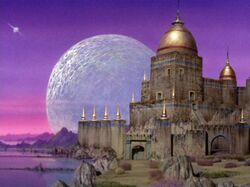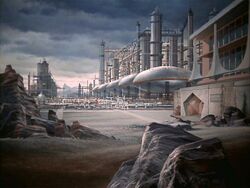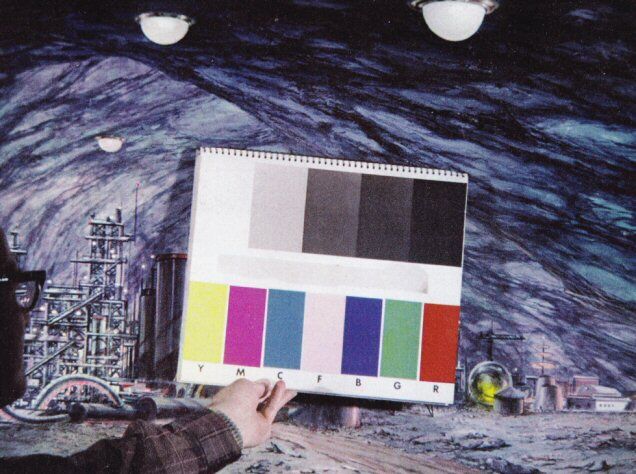
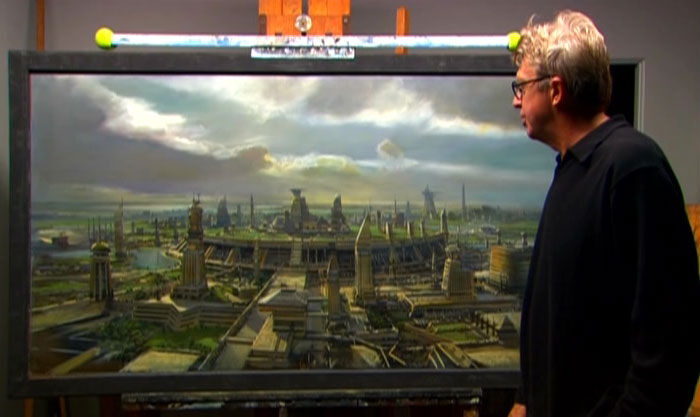
A matte painting is a form of artwork that is added to live-action footage to enable filmmakers to create the illusion of environments that would otherwise be too expensive or impossible to build or visit. Such paintings were used for planetary scenes in many Star Trek films and television series. Even though the nomenclature suggests art, as production asset, a matte painting is currently understood to be a visual effects (VFX) element and as such is created under the auspices of the production's respective VFX companies, instead of that of the studio's art department. Traditionally done on glass or other transparent materials for lighting purposes, the traditional methods of creating matte paintings are currently all but replaced by the technique of computer generated imagery.
Original series paintings
For Star Trek: The Original Series, matte paintings were usually on glass and were backlit. (Trek: The Unauthorized Story of the Movies, p. 42) Even they were too costly for frequent use in the series, though they always increased visual scope to an episode. ("The Menagerie, Part I" text commentary, TOS Season 1 DVD) All the matte paintings for TOS were done by Albert Whitlock. [1] He noted, "I only had about a week to do each one, mostly futuristic architecture." (Cinefantastique, Vol. 27, No. 11/12, p. 72) The scenes that the paintings represented include:
- Rigel VII ("The Cage" and "The Menagerie, Part II")
- Delta-Vega Station on Delta Vega ("Where No Man Has Gone Before")
- Eminiar VII ("A Taste of Armageddon")
- Underground colony on Janus VI ("The Devil in the Dark")
Clouds surrounding the city of Stratos in "The Cloud Minders" were also represented with a matte painting. (Star Trek: The Original Series 365, p. 329) Also, various matte paintings were created for Starbase 11 (for both "Court Martial" and "The Menagerie, Part I").
The matte paintings of Rigel VII, the Delta-Vega Station, Eminiar VII and the underground colony on Janus VI were all reused to depict other locations (namely, Holberg 917G, the Tantalus Colony on Tantalus V, Scalos and caves housing the Providers on Triskelion in the original versions of "Requiem for Methuselah", "Dagger of the Mind", "Wink of an Eye" and "The Gamesters of Triskelion", respectively). Similarly, the painting of the Delta-Vega Station inspired the cover of the magazine Galaxy from DS9: "Far Beyond the Stars".
Star Trek: The Original Series matte paintings
Films
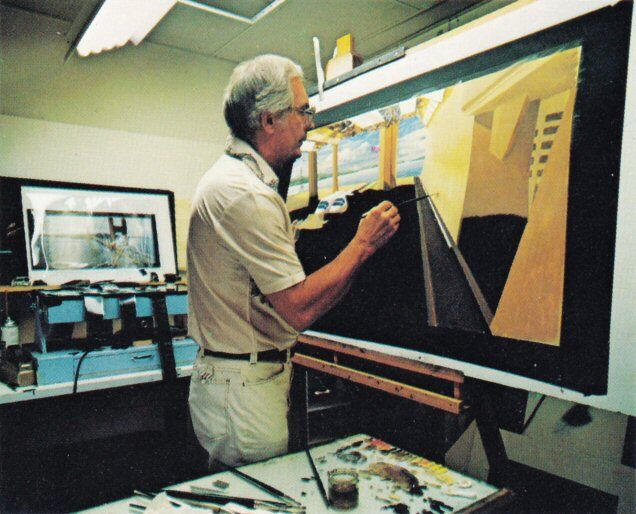
For Star Trek: The Motion Picture, approximately one hundred matte paintings were used. (The Making of Star Trek: The Motion Picture, p. 212) There were two particularly major examples of the matte paintings created for the film: as two backgrounds for planet Vulcan, which were combined with live-action footage filmed at Yellowstone National Park and Paramount's B Tank, [2](X) and a skyline for San Francisco, including Golden Gate Bridge and Starfleet Headquarters. (The Making of Star Trek: The Motion Picture, p. 212) The latter was reused as stock footage in VOY: "Non Sequitur". The film's "wing walk" sequence involved a matte painting of the Enterprise's saucer section. (The Making of Star Trek: The Motion Picture, p. 212) For the director's cut of the film, these matte paintings were replaced by CGI digital mattes. The ceiling of the recreation room in the scene where the ship's crew was assembled was also a matte painting. The set was built without a ceiling, and the visible lighting necessary to film the scene was replaced by the matte painting in post-production. Matte paintings were also used to optically enlarge such areas as the air tram station in San Francisco and the Enterprise's cargo bay. (The Making of Star Trek: The Motion Picture, interior colored photographs) Sketch test renderings of the cargo bay in different configurations were done by Andrew Probert, some of which featured long range shuttles. (The Art of Star Trek, p. 167) The shuttles were excluded from the final version, though. Probert noted, "When they did the final matte painting, they omitted shuttles of any kind." [3] The matte painting of the air tram station was created by Matthew Yuricich, the film's regular matte artist. (The Making of Star Trek, interior color photographs)

For the film Star Trek II: The Wrath of Khan, three matte paintings, created by Industrial Light & Magic, helped enhance the illusion of the Genesis cave. The main painting was done by matte artist Chris Evans and was photographed by Neil Krepela and Craig Barron. Two more paintings, one by Frank Ordaz and another by Chris Evans, were also used for the cave. (The Making of Star Trek II: The Wrath of Khan, p. 137) Director Nicholas Meyer commented that the matte painting was mainly a cost-saving device, and he thinks it looked cheap and unconvincing. If time and budget had allowed, he would have filmed the Genesis cave on a real location. (audio commentary, Star Trek II: The Wrath of Khan (The Director's Edition) DVD)

For Star Trek III: The Search for Spock, a matte painting was used for views of the Enterprise through a row of large windows in the Spacedock cafeteria. This painting simply enlarged the windows that were built for the cafeteria set, extending them upward. (Trek: The Unauthorized Story of the Movies, 3rd ed., p. 94; text commentary, Star Trek III: The Search for Spock (Special Edition) DVD) At least three more matte paintings were used for the Genesis planet, helping give the impression that scenes on the planet's surface were outside. (The Making of the Trek Films, p. 57) Although matte paintings are relatively expensive, their use in the Planet Genesis scenes was an economically sound investment, as they reduced the required size of the set for the planet. (text commentary, Star Trek III: The Search for Spock (Special Edition) DVD) Several more matte paintings were created for Vulcan and Mount Seleya. (Star Trek: The Magazine Volume 3, Issue 8, p. 27) One of these was later reused in Star Trek IV: The Voyage Home. (text commentary, Star Trek IV: The Voyage Home (Special Edition) DVD) The matte paintings of Star Trek III were created by Chris Evans, Michael Pangrazio and Frank Ordaz. (text commentary, Star Trek III: The Search for Spock (Special Edition) DVD)
For Star Trek IV, a matte painting backdrop was created for Starfleet Command, combined with live-action footage of extras and shuttlecraft models. Stock footage of this sequence was reused in TNG: "Conspiracy". For footage of a wild storm in the film, the effects artists intentionally avoided using matte paintings. "The biggest difficulty [with creating the storm footage] was doing it without going for tons of miniatures and matte paintings," recalled Optical Supervisor Ralph Gordon. (The Making of the Trek Films, 3rd ed., p. 72)
For Star Trek V: The Final Frontier, two matte painting landscapes of Yosemite National Park were created by Illusion Arts, Inc., who were already working on Star Trek: The Next Generation at the time. [4](X)

For the film Star Trek VI: The Undiscovered Country, Matte World was assigned to create three matte paintings. These did not include an establishing shot of Starfleet Headquarters that appears early in the film. Associate producer Brooke Breton explained, "This shot was added so very late in the schedule that we didn't even have the time to do a matte painting [for it] [...] since the matte department here was busy on Hook." The shot was instead created via the less time-consuming method of combining miniature elements with a live-action plate, the latter of which featured the Golden Gate Bridge. (Cinefex, No. 49, pp. 41 46, 48) The three settings for which Matte World did work were:
- Courtroom on Qo'noS (Cinefex, No. 49, pp. 53–54)
- Rura Penthe (Cinefex, No. 49, p. 54)
- Khitomer (painted by Michael Pangrazio; Cinefex, No. 49, pp. 57–59)
For the opening shot of Star Trek: First Contact, Syd Dutton and Bill Taylor of Illusion Arts provided matte painting enhancement, creating several Borg interior illustrations. (The Making of Star Trek: First Contact, pp. 121–122) Another matte painting – an enlarged, super-detailed one – was prepared to matte into the film's spacewalk sequence, though it was deemed unnecessary as the Sovereign-class model was sufficiently detailed as to be used instead. (The Making of Star Trek: First Contact, p. 116) Matte World also did some matte painting work for the Vulcan landing sequence in First Contact, using miniature trees. This work included the last shot of the movie, for which Vision Arts provided the Vulcan ship, the T'Plana-Hath. [5]
Feature film matte paintings

Star Trek: The Motion Picture

Star Trek: The Motion Picture, VOY: "Non Sequitur"

Star Trek: The Motion Picture

Star Trek II: The Wrath of Khan

Star Trek III: The Search for Spock

Star Trek III: The Search for Spock
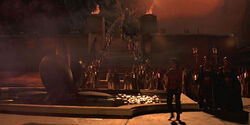
Star Trek III: The Search for Spock

Star Trek III: The Search for Spock, Star Trek IV: The Voyage Home

Star Trek IV: The Voyage Home

Star Trek IV: The Voyage Home, VOY: "Persistence of Vision"

Star Trek V: The Final Frontier (deleted scene)

Star Trek VI: The Undiscovered Country

Star Trek VI: The Undiscovered Country

Star Trek: First Contact, ENT: "In a Mirror, Darkly"

Star Trek: The Motion Picture

Star Trek: The Motion Picture

Star Trek: The Motion Picture

Star Trek: The Motion Picture

Star Trek II: The Wrath of Khan

Star Trek III: The Search for Spock

Star Trek III: The Search for Spock

Star Trek III: The Search for Spock

Star Trek IV: The Voyage Home, TNG: "Conspiracy", VOY: "Non Sequitur"

Star Trek IV: The Voyage Home

Star Trek V: The Final Frontier

Star Trek VI: The Undiscovered Country, VOY: "Non Sequitur", "In the Flesh"

Star Trek Generations
Paintings for spin-off series

During production of Star Trek: The Next Generation, the regular matte artists were Syd Dutton, Robert Stromberg and Eric Chauvin, who worked for the now defunct Illusion Arts, Inc., a company specializing in matte paintings. [6](X) However, visual effects supervisor Dan Curry also contributed some of the paintings. He stated, "I've been learning matte painting but on a small scale only." (Star Trek Monthly issue 32, p. 72)
For the first season, Illusion Arts created three matte paintings. The first represented the surface of Ligon II in "Code of Honor". The second was used to represent the surface of Angel I, in "Angel One". This matte painting was reused several times during the first three modern Star Trek series: in "Samaritan Snare" (as Starbase 515), "First Contact" (as Malcor III), "The Mind's Eye" (slightly modified, as Krios Prime), DS9: "Dax" (as Klaestron IV), and VOY: "Ex Post Facto" (as Banea). The third matte painting was created to represent the surface of Velara III in "Home Soil". [7](X)
For the second season, two matte paintings were created: the first to represent the Darwin Genetic Research Station for "Unnatural Selection". It was later reused to represent Arkaria Base in "Starship Mine", and Ohniaka III Research Station in "Descent". The second was created for "Q Who" to represent the vast interior of the Borg cube. [8](X)
Three matte paintings were created for the third season. The first, to represent the surface of Tau Cygna V for "The Ensigns of Command". The second was created to represent Qo'noS in "Sins of The Father". This matte painting was reused many times during the three modern spin-off series, when the Klingon capital planet was featured. Also, a matte painting backdrop was created for the surface of Jouret IV for "The Best of Both Worlds", expanding the planet set which was created on Paramount Stage 16, by Richard James, who also oversaw the creation of the matte. ([9](X); "The Best of Both Worlds" text commentary, Star Trek: Fan Collective - Borg)
Two matte paintings were made for the fourth season. The first was a backdrop for La Barre, France in "Family". The second was created to represent the surface of Ventax II in "Devil's Due". [10](X)
The fifth season introduced the matte painting for Romulus, in "Unification I", another painting that was reused many times, when the Romulan capital was featured. This season also saw a matte panting for Moab IV in "The Masterpiece Society", one for Penthara IV in "A Matter Of Time", and finally, another frequently reused illustration: a matte painting of Starfleet Academy in "The First Duty", extending the footage filmed at Tillman Water Reclamation Plant. [11](X)

For the Star Trek: Voyager pilot episode "Caretaker", Illusion Arts created a matte painting of the underground Ocampa city. (Star Trek: Voyager - Inside the New Adventure) The surface of Ocampa was also shown using a matte painting, after Dan Curry created numerous different electronic sketches of matte painting elements. (The Art of Star Trek, pp. 134–135)
One unusual use of a matte painting is featured in the main title sequence of Voyager, representing an icy moon that the starship Voyager flies over. John Grower, the founder of Santa Barbara Studios, stated, "This foreground moon was actually a matte painting done by Craig Mullins, but then we took the matte painting and mapped it onto three-dimensional geometry, so it became a 3-D matte painting. We painted what's called a height-map that's a black-and-white map in which the bright parts extend closer toward you, and the dark parts get pushed back. You're essentially painting and creating three-dimensional geometry by playing with the contrast between white and black. You place the painting onto this geometry, and now you have a three-dimensional surface that you can rotate. You can have perspective happen within the painting." (Star Trek Monthly issue 10, p. 15)
Another matte painting was created by Open Films for the fourth season Voyager episode "Waking Moments". (Star Trek: Voyager Companion, p. 463)
For Star Trek: Enterprise, Syd Dutton of Illusion Arts created matte paintings of Qo'noS, as is first shown in the pilot episode "Broken Bow", and a devastated Earth city for the first season cliffhanger "Shockwave". ("Broken Bow" text commentary, ENT Season 1 DVD; [12](X))
Star Trek: The Next Generation matte paintings

TNG: "Encounter at Farpoint"

TNG: "Code of Honor"

TNG: "Angel One", "Samaritan Snare", "First Contact", DS9: "Dax", VOY: "Ex Post Facto"

TNG: "Coming of Age"

TNG: "Loud As A Whisper"

TNG: "Unnatural Selection", "Starship Mine", "Descent"

TNG: "Q Who", "The Best of Both Worlds"

TNG: "The Survivors"

TNG: "The Defector"

TNG: "The Hunted"

TNG: "Sins of The Father", "Redemption", DS9: "The House of Quark"

TNG: "Ménage à Troi"

TNG: "Legacy", DS9: "Armageddon Game", VOY: "Unity"

TNG: "Devil's Due"

TNG: "Identity Crisis"

TNG: "Redemption II"

TNG: "The Game"

TNG: "A Matter Of Time"

TNG: "The First Duty", "Time's Arrow"

TNG: "The Inner Light"

TNG: "Chain Of Command, Part I"

TNG: "Lessons"

TNG: "Rightful Heir"

TNG: "Force of Nature"

TNG: "All Good Things..."

TNG: "Encounter at Farpoint"

TNG: "Too Short A Season"

TNG: "11001001", "Remember Me"

TNG: "Home Soil"

TNG: "Coming of Age"

TNG: "We'll Always Have Paris", Star Trek VI: The Undiscovered Country
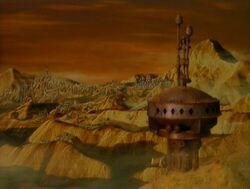
TNG: "Contagion"

TNG: "Pen Pals"

TNG: "The Ensigns of Command", DS9: "The Maquis, Part I"

TNG: "The Vengeance Factor"

TNG: "Sins of The Father", "Redemption", "Redemption II", DS9: "The House of Quark"

TNG: "Captain's Holiday"

TNG: "The Best of Both Worlds"
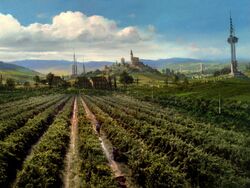
TNG: "Family"

TNG: "Future Imperfect"

TNG: "First Contact"
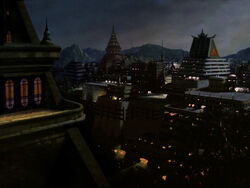
TNG: "The Mind's Eye"

TNG: "Silicon Avatar"

TNG: "Unification II", "Unification I"

TNG: "The Masterpiece Society", "Chain Of Command, Part I"

TNG: "I Borg"

TNG: "Relics"

TNG: "Starship Mine"

TNG: "Lessons"

TNG: "Liaisons"

TNG: "All Good Things..."

TNG: "All Good Things..."
Star Trek: Deep Space Nine matte paintings

DS9: "Emissary", "In the Hands of the Prophets", "The Circle", "Cardassians", "The Collaborator", "Shakaar" et al.

DS9: "Shadowplay", TNG: "Preemptive Strike"

DS9: "Meridian"

DS9: "Homefront"

DS9: "The Quickening"

DS9: "Rapture"

DS9: "The Homecoming"

DS9: "Rules of Acquisition"
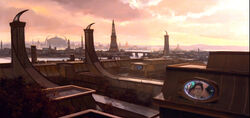
DS9: "Tribunal", "Second Skin", "Defiant" et al.

DS9: "Equilibrium"

DS9: "Family Business", "Ferengi Love Songs"

DS9: "Let He Who Is Without Sin..."
Star Trek: Voyager matte paintings

VOY: "Caretaker"

VOY: "Caretaker"

VOY: "Caretaker"

VOY: "The Raven"

VOY: "Caretaker", VOY: "Displaced"

VOY: "Caretaker"

VOY: "Lifesigns"

VOY: "Year of Hell", "Virtuoso"
Further reading
- Industrial Light & Magic: The Art of Special Effects, Chapter 7, 1986
- "Matte Artistry", David Hutchison, Starlog photo guidebook Special Effects, Vol. 2, 1980, pp. 10–33
- "The Art of Alien Worlds", VOY Season 4 DVD, special feature
- "Matte Painting", Ron Magid, Cinefantastique, Vol 17 #3/4, 1987, p. 43
- "Painting The Future", Tim Prokop, Cinefantastique, Vol 25 #6/Vol 26 #1, 1994, pp. 70–73
- "The Art of Matte Painting", Star Trek: The Magazine Volume 3, Issue 12, pp. 24–29
External links
- Matte painting at Wikipedia
- Planet Surfaces in TOS and TOS Remastered at Ex Astris Scientia
- Matte Shot – a tribute to Golden Era special fx – specialty blog, including entries on Star Trek matte painters
